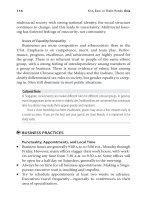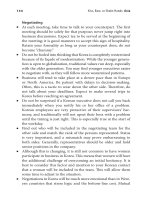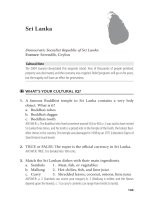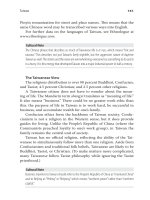How to Understand Business Finance, Second Edition_7 potx
Bạn đang xem bản rút gọn của tài liệu. Xem và tải ngay bản đầy đủ của tài liệu tại đây (184.56 KB, 18 trang )
98 How to Understand Business Finance
Sales multiplier
The sales multiplier uses a multiple of sales to assign a value to
that company. This could be less than or greater than 1, depending
on expectations for future growth. Sales multipliers are
particularly popular in start-up companies that are not yet
profi table (eg dot.com companies).
Profi t multiplier
In the case of the profi t multiplier, the multiplier used tends to be
greater than 1 and will be based on how many years’ future profi t
are to be factored into the value of a business as well as
expectations for future profi t growth.
So if a profi t multiplier of 10 was used you might expect a
10 per cent return for the next 10 years, with no change in
business conditions to pay for this investment.
Market capitalisation
As mentioned in Chapter 7, the value of a company can be
ascertained by multiplying the number of issued shares by the
current share price. This is known as market capitalisation.
A case for asset stripping?
We can use the information from the case study above to do
the fi nancial analysis shown in Table 8.2.
The concept of asset stripping is to buy out a company’s
shares for less than the value of the assets and then to sell
99 Valuing a Company
these at a profi t. Best might therefore be a candidate for this
treatment based on these calculations.
This is why company directors get worried when their
share price falls too low!
Table 8.2 Analysing the case for asset stripping
Company
Ace Best Cool Demon Excel First
Net
assets (£)
34,000 43,000 55,000 62,000 77,000 65,000
Sales
multiplier
(×1.5)
150,000 180,000 225,000 240,000 270,000 300,000
Profi t
multiplier
(×4)
40,000 48,000 72,000 72,000 72,000 72,000
Market
capital-
isation (£)
30,000 25,500 46,000 54,000 75,000 63,000
Balanced Scorecard
As already mentioned, there are often non-fi nancial
considerations to valuing a company. Norton and Kaplan
developed the idea of a scorecard that balances fi nancial and
non-fi nancial measures, to help manage a company; but these
ideas can also help us value one. Non-fi nancial measures might
include:
100 How to Understand Business Finance
Health, safety and environment• – many companies have
policies relating to these factors and would seek an
acquisition that might enhance their position in these
areas. This could include accident rates, environmental
impact and energy usage.
Production measures – these will vary from one industry •
to another but might include production effi ciencies,
output per worker, waste levels and how up to date the
production processes are.
Intellectual property – the potential value of patents, •
trademarks and brands.
Employees – the skills, motivation, satisfaction levels, •
productivity and loyalty of the people who work in the
company.
Marketing – geographic coverage, customer satisfaction •
and loyalty, market share and potential fi t with existing
activities have a value that can be diff erent for diff erent
purchasers. The outlook for future growth might lead to
an expectation of a better performance in the future, as
could the rate of product and process innovation, and
percentage of sales from new products.
Strategic fi t – diffi cult to quantify, and used to justify •
high acquisition costs! Companies will also claim to be
able to gain synergies and cost savings through merging
the two organisations.
Cash fl ows
When considering purchasing a company, another way to value
the business is to examine what cash it will generate over a period
of time. This can be in straight cash terms not taking into account
infl ation, price erosion etc. You may also wish to apply discounted
cash fl ow principles (see Chapter 13) to arrive at a net present
value (NPV) for the company, or even an internal rate of return
(IRR) on the purchase.
101 Valuing a Company
Perhaps the most useful way to value it is to estimate the
economic profi ts that the business will generate in the next few
years (see Chapter 9) and then apply the NPV process to them. All
valuations based on forecast fi gures are essentially educated
guesses, but this analysis is likely to pinpoint the best opportunity
for creating value, if the forecasts turn into reality.
102
THIS PAGE IS INTENTIONALLY LEFT BLANK
9
Shareholder value and
economic profi t
Shareholders invest in a company to make a profi t. This can come
from an increase in the share price and/or the dividends the
company pays. Both share prices and dividends have been discussed
in detail in Chapter 7. The challenge is to fi nd a measure of business
performance that correlates with share price movements. Then, if
we plan our business to raise this measure, we should raise the
share price, and hence create value for our shareholders.
Earnings before interest, tax,
depreciation and amortisation
(EBITDA)
Profi t is not a good measure of the value a business is generating
for its shareholders. Ultimately, a shareholder is interested in the
amount of cash generated, rather than profi t (which is after all
only an accounting calculation). It is cash which enables the
business to expand and develop, and pay dividends. And it is the
103
104 How to Understand Business Finance
expectation of future cash fl ows that drives the share price up, and
creates values for shareholders.
In calculating profi t, depreciation is included as a cost.
Depreciation and amortisation are not cash transactions but
an accounting exercise to balance the reducing value of assets
over time. We can measure earnings before interest, tax,
depreciation and amortisation – EBITDA! This is the amount of
operating profi t that will eventually be turned into cash. But
EBITDA alone doesn’t tell us if we are creating value.
Economic profi t
Economic profi t (EP)
1
takes account of the fact that investors have
choices. They can invest in your company, or your competitor; in
art; in another industry; or put their money in the bank. Every
investment has a certain amount of risk, and a level of reward.
If your company generates more cash from each pound
invested than other investments with a similar level of risk, it is
making an ‘economic profi t’. Studies of real companies show
clearly that an increase in EP correlates strongly with an increase
in share price, and the creation of shareholder value. A fall in EP
goes with a reduction in share price, and destruction of
shareholder value.
Economic profi t is calculated by taking the cash fl ow
generated by the business (EBITDA) and subtracting a ‘charge’ for
the ‘cost of capital’. The cost of capital is the profi t the business
must make, simply to meet the expectations of investors who take
this level of risk.
If the company was fi nanced only by shareholders’ funds, the
cost of capital would be the average return of investments after tax
with the same level of risk; for example, a group of companies of
similar size in the same industry. This is the ‘cost of equity’.
1
EP is also known as economic value added (EVA
®
), net contribution to value (NCV)
and shareholder value added (SVA). EVA
®
is a registered trademark of the Stern
Stewart Corporation.
105 Shareholder Value and Economic Profi t
Most companies are fi nanced partly by shareholders’ funds,
and partly by bank loans. So, their cost of capital is not simply the
cost of equity, but takes into account the interest paid on loans as
well. This is known as the ‘weighted average cost of capital’, or the
WACC rate.
Economic profi t is calculated by subtracting a capital charge
(the net asset value of a business multiplied by the WACC rate)
from EBITDA. Tax is also deducted because this is paid out of cash
fl ow. Interest is not deducted, as the capital charge has already
taken this into account.
Thus, in the example shown in Table 9.1, while Cool’s profi ts
are in line with those of several of the other companies, it is
creating more value (over and above the cost of the money tied up
in that business) than its competitors.
Table 9.1 Economic profi t = Profi t – Tax – Capital charge
£ Company
Ace Best Cool Demon Excel First
Profi t
(earnings)
10,000 12,000 18,000 18,000 18,000 18,000
Tax (33%) 3,300 4,000 6,000 6,000 6,000 6,000
Net
assets
34,000 35,000 55,000 62,000 77,000 65,000
Capital
charge
(10%
WACC rate)
3,400 3,500 5,500 6,200 7,700 6,500
Economic
profi t
3,300 4,500 6,500 5,800 4,300 5,500
106 How to Understand Business Finance
Total shareholder return (TSR)
Recently, economists have come up with a further measure of
returns for the shareholder. While profi ts are owned by the
shareholders, they are not necessarily paid out as dividends,
and may be retained in the business to fund its growth. For
instance, biotech companies often do not pay a dividend to
their shareholders.
In reality the return a shareholder sees is the increase in the
share price over time, and the cash dividends received from the
company. Typically this TSR is normally calculated over the past
three to fi ve years.
This can be further complicated by using discounted cash
fl ow to refl ect the fact that money earned in the future is worth
less than its worth today. TSR calculated in this way is used by a
number of companies, but there is little evidence that the stock
markets have adopted this as a measure of shareholder value
over more conventional measures such as the share price and
profi t performance.
Recently, Unilever used this concept and concluded that
making a cash distribution represented better shareholder
value than retaining it in the business for future growth. On
making this payment the share price collapsed, because
economists had forgotten the psychological eff ect this
payout would make. Shareholders said, ‘Thanks for the
bonus, I’m not likely to get a payout like that again, I’ll
invest the money somewhere else!’ and all tried to sell their
shares. Strangely, a short time later Unilever borrowed
money to make an acquisition and the share price went up
again as investors believed the company would be able to
make better profi ts in the future as a result of better use of
this funding.
107 Shareholder Value and Economic Profi t
A drawback of looking at TSR is that we are either looking at
historic performance over the last three to fi ve years (which is not
necessarily an indication of future trends) or we are estimating
future values (say, for the share price) which are not always borne
out in practice.
108
THIS PAGE IS INTENTIONALLY LEFT BLANK
10
The hidden costs –
depreciation, amortisation
and tax
Depreciation and amortisation are fi nancial conventions used to
take account of the fact that assets reduce in value over time. In
some cases, such as vehicles, they simply wear out, even if they are
well maintained. In other cases, such as software, they may become
obsolete, and need to be replaced even though they work perfectly.
This can happen simply because there is now a better product
available, and the cost of using the old one is much higher than the
cost of using the new one. So, accountants have to estimate the
useful life of an asset when it is bought, using their best judgement.
If they overestimate this, the asset may be worthless while it still
shows as an asset on the books. On the other hand, some assets
outlive their expected working life, and still have real value many
years later, but don’t appear on the balance sheet any more.
The depreciation and amortisation is the amount by which the
assets are reduced in value during each accounting period. This is
taken as a charge in the P&L, as a fi xed cost or expense.
We have already established that assets are normally valued
by accountants at what they cost, and this is known as the book
value of the asset. This book value then reduces by the amount
that the asset is depreciated or amortised over time.
109
110 How to Understand Business Finance
Land and buildings are not normally depreciated in the United
Kingdom, as they are not ‘worn out’ in use. However, in recent
times where land and buildings become contaminated, the
remediation costs may drastically reduce their value.
This chapter outlines the concepts of depreciation and
amortisation, but every company has its own policies, so you
should ask your fi nancial staff to explain how these operate in
your own company.
Generally it is becoming accepted practice that
depreciation is used for tangible assets (physical items
such as cars, computers, equipment etc) and
amortisation for intangible assets (goodwill, capitalised
costs etc – explained later). Remember that both
depreciation and amortisation are accounting
conventions to take account of the reducing value of
assets. Because something changes on the top half of the
balance sheet, we must make an adjustment to the
bottom half. This is done by reducing the profi t carried
across the page from the P&L account by the amount of
the depreciation and amortisation. This is only a paper
exercise – the cash in the bank does not change as a
result of this adjustment in the value of the assets and so
accountants will tell you, ‘This is not a cash transaction’
– it has no impact on cash.
Depreciation
There are two main methods for calculating depreciation. First, an
assumption has to be made of the economic life of an asset. So, for
instance, a car may be depreciated over four years, while a
computer might be depreciated over two years, and production
equipment over 10 or 20 years.
111 The Hidden Costs – Depreciation, Amortisation and Tax
Most companies have a depreciation policy set by their
fi nance department. One organisation depreciates its plant and
equipment over 17 years – and no one seems to know why at some
point in the company’s history this fi gure was selected!
Straight line depreciation
The fi rst method of depreciation is called straight line
depreciation and reduces the value of the asset by an equal
amount for each period throughout its life (see Figure 10.1). So, if
an asset has an original value of 100 and has a useful life of 10
years, the depreciation would be 10 per year using this approach.
After 10 years the asset will have a zero book value and can no
longer be depreciated. This is known as a fully depreciated asset.
The advantage of this method is its simplicity. The
disadvantage is the fact that at some point the asset has no book
value, which does not necessarily refl ect the real situation. This
can be a problem when a business has become accustomed to a
0
10
20
30
40
50
60
70
80
90
100
0246810
Year
Asset value
Asset value
Figure 10.1 Straight line depreciation
112 How to Understand Business Finance
level of profi t without any depreciation charges, from a fully
depreciated manufacturing asset. As soon as any capital
improvements are made to the equipment the business will have
depreciation charges from these improvements, and profi t will
reduce for no apparent reason.
So, for instance, when some smart young engineer comes along
and wants to automate the plant, profi ts could go down! That said,
perhaps the automation would reduce fi xed costs (fewer workers may
mean a lower wage bill), thus off setting the new depreciation charges.
Reducing balance depreciation
Alternatively, the value of an asset can be reduced by a set
percentage each period (see Figure 10.2). So, for the example
above, the percentage used would be 10 per cent based on a 10-year
life. Each year the value of the asset is reduced by 10 per cent, but
after 10 years the asset will still have some residual book value.
Each year the amount of depreciation reduces and neither the
depreciation nor the book value of the asset ever becomes zero.
0
20
40
60
80
100
0246810
Year
Asset value
Asset value reducing
by 10% per year
Figure 10.2 Reducing balance depreciation
113 The Hidden Costs – Depreciation, Amortisation and Tax
The advantage of this method is the fact that the asset usually
has some residual value even at the end of its useful life, and this
is refl ected in the fi nal book value. The disadvantage is the
complexity of managing many diff erent assets at diff erent stages
in their life, and the ever-changing amount of depreciation, which
aff ects the profi ts of a company.
It is because fi xed assets are valued at their depreciated ‘book
value’ that it is so important for a company to maintain a fi xed
asset register (mentioned elsewhere in this book).
Goodwill
Goodwill is simply the diff erence between what is paid for an
asset and its book value. It usually comes into consideration when
a company makes an acquisition. There are many reasons for
paying more than the book value for an asset. First, the book value
of an asset in the accounts may not refl ect its true market value.
For instance, land and buildings may be valued in the books at
what was paid for them (historic value), even if this was many
years before, and their value may have changed signifi cantly.
When buying a business that is already established, there are
many intangible aspects such as the staff (which you will recall
accountants put no value on, except for instance in football clubs),
market position, brands, technology and intellectual property,
which all have a value. This might help to explain why Nestlé paid
many times the value of the production assets to acquire the
Rowntree confectionery company, which included the global
brands Kit-Kat and Smarties, neither of which were valued on
Rowntree’s balance sheet.
Goodwill is treated as an intangible asset and is placed on the
balance sheet as a separate item from the tangible assets.
Companies must decide whether to carry the goodwill indefi nitely,
amortise goodwill over a number of years, write it off against profi ts
immediately, or revalue the assets. What is this intangible asset? It
does not physically exist; it is just the diff erence between what is
paid for an asset and its value in the books (on the balance sheet).
114 How to Understand Business Finance
Intangible assets
Companies will often acquire and develop items that are not
physical materials. This can include such things as trademarks,
intellectual property (eg patents) and brands, customised
software, databases and market research information.
Accountants tend only to put a value on tangible assets such as
buildings and equipment.
Accountants argue that these other assets are somewhat
transient. Consider the Perrier water brand. This was the
number one branded bottled water before the problem the
company had with contaminated bottles. When the company
had to withdraw all its stock from the shops, the value of the
brand dramatically declined. It was only by considerable
eff orts in both rebranding and launching new products that
Perrier has been able to re-establish its market position.
So, accountants defi ne as intangible any asset on the balance
sheet that has been paid for, but is not a physical item. Such assets
have to be on the balance sheet because we have taken one item –
cash – and turned it into another – an intangible asset. Without
this being listed, the books would no longer balance.
As mentioned earlier, these intangible assets can be reduced
in value over time by amortisation, in just the same way that
tangible assets (eg equipment) are depreciated over time. Below is
a further example of use of this mechanism with the capitalisation
of costs.
Capitalising costs
Consider a pharmaceutical company that has to pay £400 million
to research a new drug. Normal accounting convention would
115 The Hidden Costs – Depreciation, Amortisation and Tax
suggest that all development costs must be taken in the P&L
account as they occur. In this case, it would be before any sales of
the new drug had even taken place.
Companies capitalise costs so that they can match that cost
with the timing of the sales income stream. The initial cost
(£400 million in the pharmaceutical company example) is put
on the balance sheet as an intangible asset, and then amortised
in the same way as depreciation over the life of the project. If the
life of the patented drug was 10 years from launch, the
pharmaceuticals company might take an amortisation charge of
£40 million per year over the life of the patent, following the
launch of the drug. In this way it matches the research costs in
the P&L account with the sales activity of the drug.
The downside of this technique is that whether the drug
succeeds or fails, the amortisation costs remain. So, if the drug
were withdrawn and had no further sales, a decision would have
to be made whether to continue the amortisation charge each
year, or write off the remaining value of the research from the
balance sheet as one single charge in the P&L account.
Examples of items that might be capitalised include research,
design and development costs, start-up and commissioning costs,
refurbishment and overhaul costs, product launch costs and
promotional campaigns. In principle, any cost which benefi ts the
business for more than 12 months could be capitalised.
Taxation
Of the two certainties in life, it is sometimes debatable which is
the worse to contemplate – death or taxes. The complexities of the
tax system can bring grown men to tears, let alone what it does to
their profi ts. After depreciation, more people probably get
confused about tax than any other aspect of the accounts. It
certainly deserves a brief and simple review. This is based on a UK
company. We will have a quick look at value added tax (VAT),
income tax (Pay As You Earn, PAYE), National Insurance (NI) and
corporation tax.









